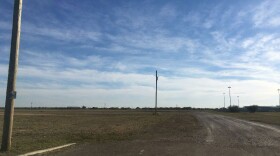President Trump is considering sending a new round of troops to the southern border. The military withdrew some service members from the border in December, after they laid miles of concertina wire – large steel coils with razor-sharp teeth.
In November, President Trump tweeted a photo of the border wall near the Pacific Ocean wrapped in concertina wire. The president's tweet said "No climbers."
Shortly afterward, then-Homeland Security Secretary Kirstjen Nielsen visited the same spot in a San Diego park, using the wire as a backdrop for a speech.
"This is a border wall with row upon row of concertina wire," Nielsen said. "We are very serious. You will not get into our country illegally."
Officials said that laying the wire was among the primary reasons why troops were deployed to the southern border late last year. About 1,800 troops assigned to the border have now left, according to U.S. Army North, which is in charge of the Army's border operation. But most of the wire remains in place.
At Friendship Park, where the U.S. border fence with Mexico meets the Pacific Ocean, the concertina wire is starting to sag in spots. Debris is caught in the barbs at the top of one section. At the base of the fence, some of the wire is tangled. At some points, the concertina wire stops. A smaller section of wire that was set up on the beach is now a tangle of wire.
It is up to the Department of Homeland Security to maintain the wire, said Army Col. Catherine Wilkinson, a spokesperson for U.S. Army North.
Meanwhile, leaders of some border communities are raising questions about why the wire was placed in certain areas, while other nearby parts of the border have no wire.
"If you go east and west of our city, about two and a half miles, there is no wall, there is no fence, there is nothing," said Nogales, Ariz. Mayor Arturo Garino. "So why put it in downtown Nogales in our business area, in our tourist area?"
The Nogales City Council has demanded that the federal government take down the rows of wire strung along the border fence through the city's downtown. City leaders say they're worried about children getting hurt. The small U.S. city also depends on people coming from Mexico to shop, and leaders are concerned the wire sends the wrong message.
Originally, the troops strung two rows of wire, the mayor said. The city was upset when troops came back to cover the entire border wall from top to bottom downtown.
The Pentagon has said troops put the wire wherever the Border Patrol and Homeland Security asked them to place it.
In Arizona, the local Border Patrol agent in charge, Sabri Dinkman, told Arizona Public Media that several factors went into the decision about where to install the wire.
"We looked at places where we need to have impedence. We need to have time for our agents to react to attempted illegal entries," Dinkman said.
Dinkman said the extra wire downtown is necessary.
"They were cutting it, crossing," he said, "and so the extra layers of concertina wire provided a deterrent. Since we've had the extra layers of concertina wires on the fence in Nogales, we've only had one attempted breach of those areas."
Other communities along the border have questioned leaving the wire in place. The city of McAllen, Tex., took down wire strung around some municipal buildings at the border. In Laredo, Tex., some wire was quietly removed in December after residents objected.
The Border Patrol in San Diego said in a statement that it wanted the wire in high-traffic areas, including around ports of entry.
The Pentagon says a total of 180 miles of wire was laid along the border beginning in October, including 46 miles in California, 64 miles in Arizona, and 70 miles in Texas.
Some U.S. troops remain along the border, and President Trump has said he plans to send more, so communities could see a new round of concertina wire in the coming months.
This story was produced by the American Homefront Project, a public media collaboration that reports on American military life and veterans. Funding comes from the Corporation for Public Broadcasting.





